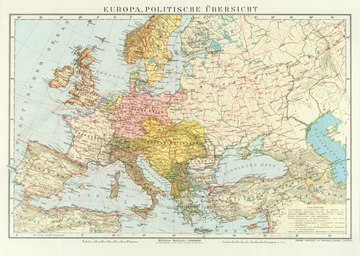Austria-Hungary – a major European power?
On the eve of the First World War Austria-Hungary was the European state with the second-largest area after Russia. In spite of its enormous size, however, the Habsburg empire was falling behind the major European powers in many respects.
The territory of the Habsburg Monarchy extended over an area of 676,615 km², in which 51.4 million people lived. A comparison with the other major powers in Europe is interesting in this regard. In 1910, the German Reich, Austria-Hungary’s closest ally, was smaller with an area of around 541,000 km², but had a much larger population, around 66 million people. France at the start of the twentieth century had an area of around 537,000 km² and 41 million inhabitants. Great Britain – more precisely the United Kingdom and Ireland – was 315,000 km² in size with 40.1 million inhabitants. All of these states also had extensive colonial possessions outside Europe, however. The largest colonial power was the British Empire, which in 1901 ruled over a quarter of the Earth’s surface. The empire of the Russian tsars was also enormous: in 1914 it covered a territory of 22.5 million km² with a population of around 163 million.
At the start of the war, the Habsburg Monarchy was able to mobilize 1.8 million combatants. The German Reich had an army of 2.4 million men. Within the Entente, France had an army of 1.9 million men and Great Britain over 655,000 in the country and a further 322,000 colonial troops stationed in India. The Russian tsar was able to send a massive 3.4 million soldiers into the field.
In economic terms, the Habsburg Monarchy at the beginning of the twentieth century was not only situated geographically between western and eastern Europe, but was also a transitional zone in regard to the level of economic development. A characteristic feature of this part of the continent was the relative tardiness in its evolution towards an industrial society. Industrialization in general was two to three decades behind western Europe. The development was not comparable with a world power like Great Britain, which had a transcontinental colonial empire. Austria-Hungary was also markedly weaker than Germany, which now laid claim to a political influence commensurate with its newly acquired status as a leading economic power on the continent. The Habsburg Empire was closest in economic terms to France, which was also a mixed industrial and agrarian society.
The importance of agriculture to the economy of the Habsburg empire is illustrated by its contribution to the overall economic performance. Although it sank between 1850 and 1910 from 67 to 53 per cent, it was still high in comparison with Germany, where the agricultural sector declined in the same period from 56 to 35 per cent. The contribution of the industrial sector in the Habsburg Monarchy rose from 20 to 24 per cent, a relatively small increase in comparison with the German Reich, where the share of industry in overall economic performance rose from 24 to 40 per cent.
Translation: Nick Somers
Bridge, Francis Roy: Österreich(-Ungarn) unter den Großmächten, in: Wandruszka, Adam/Urbanitsch, Peter (Hrsg.): Die Habsburgermonarchie 1848–1918, Band VI: Die Habsburgermonarchie im System der internationalen Beziehungen, Wien 1989, Teilband 1, 196–373
Hanisch, Ernst: Der lange Schatten des Staates. Österreichische Gesellschaftsgeschichte im 20. Jahrhundert [Österreichische Geschichte 1890–1990, hrsg. von Herwig Wolfram], Wien 2005
Rauchensteiner, Manfried: Der Erste Weltkrieg und das Ende der Habsburgermonarchie 1914–1918, Wien u. a. 2013
Rumpler, Helmut: Eine Chance für Mitteleuropa. Bürgerliche Emanzipation und Staatsverfall in der Habsburgermonarchie [Österreichische Geschichte 1804–1914, hrsg. von Herwig Wolfram], Wien 2005



